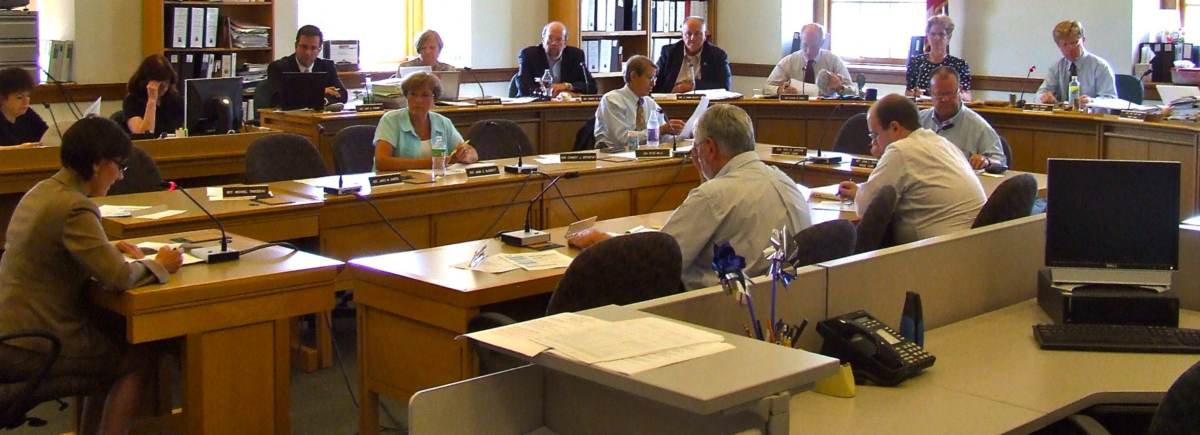Within a few years, the state’s ability pay for its daily operations and invest in its future will be threatened by an obscure budget item that doesn’t pave a road, aid the needy, imprison a criminal or help a Maine kid pay for college.
That line in the state budget pays for the pensions for state employee and public school teachers. It’s already eating up one of every 10 taxpayer dollars — and it’s going to get much worse in just a few years.
Using data provided by state agencies, a Maine Center for Public Interest Reporting analysis shows within five to six years pension costs could be 20 percent of the budget — twice, for example, what the state gives to higher education, a system with 14 campuses, 50,000 students and almost 6,000 employees.
“Its a ticking time bomb that the next governor will inherit and that people don’t understand well enough,” said Alan Caron, founder of Envision Maine, a non-partisan Maine think tank. “There isn’t going to be enough money to do what we’re already committed to doing, much less doing more of what we should be doing,”
Robert A. G. Monks of Cape Elizabeth was the head of two commissions that studied the state retirement plans in the 1980s and 1990s. He calls the looming pension costs “the 800-pound gorilla” facing the next governor.
The current and future payments to the pension system, Monks said, “will mean a process of diluting other state programs drastically.”
One of the acknowledged experts on the current state finances is Ryan Low, who just completed a term as Gov. John Baldacci’s chief financial officer.
Low agrees that starting as soon as next year, paying the annual pension costs is “going to require some substantial sacrifice from schools, from education funding, and from — well — everyone, but certainly the brunt of it will go to human services and education.”
Rep. Sawin Millett, R-Waterford, is considered by his colleagues to be the single most informed legislator on the state budget, having served in the legislature and on the executive side in fiscal roles.
He said the retirement portion of the budget is growing at twice the rate as the rest of the budget, and there’s no way out of that problem unless state revenues grow more than expected or there are new taxes.
‘We’re clearly going to have to reduce the rest of the budget. A lot of people have not fully grasped the full consequences,” said Millett.
Even the lobbyist representing the state’s cities and towns is worried.
Geoff Herman of the Maine Municipal Association said his group is concerned the escalating pension costs will, at the least, “crowd out” other state expenditures such as aid to schools and revenue sharing with municipalities. And that could mean an increase in property taxes.
The billion dollar bill
How big is the problem?
The state owes the retirement system $4,432,000,000. That’s billions, not millions.
But the amount owed is only half the story. The other half is the deadline for paying it off: the year 2028, 18 years from now.
And that deadline cannot be easily changed — it’s written into the state constitution.
In the 1980s and early 1990s, state retirees and their supporters were increasingly worried that the state was not putting enough away each year to pay for the current and future pension costs.
Because the state had not kept up with the true costs of the pensions and because it had added new benefits but not the money to pay for them, the state had built what what is called the Unfunded Actuarial Liability, or UAL.
The three words in that accounting phrase are each important. Taking them backwards, the liability refers to a debt or an expense; actuarial means the calculation of the debt is based on an analysis of factors about the current and future retirees from the system — age, life expectancy, salary, etc.; unfunded means the state knew it had this debt but didn’t have all the money set aside to pay for it.
Around the time the constitutional amendment was passed, Maine had the third worst UAL in the country. Only West Virginia and the District of Columbia were less funded. Maine’s pension fund at that time was only about 27 percent funded. It is now 65 percent funded — still a long way from the 90-100 percent recommended by outside experts.
The costs of the pensions was like a mortgage — a mortgage the state was behind on paying, but had no binding commitment to ever catch up.
No more shenanigans
David Wakelin, the former longtime chairman of the state pension system board, recalled that the retirees’ goal with the constitutional amendment was to “make it very difficult to do any shenanigans with the system,” such as delaying or reducing payments and adding new benefits without funding them fully.
Low said, “What happened before the constitutional amendment is, my understanding is — I wasn’t around — is the state would get the bill and sometimes they would make the full payment and sometimes they would pay considerably less. “
In 1995, the legislature — by a large majority — approved putting a constitutional amendment on the ballot that set a date certain for paying off the pension debt: the year 2028, more than 30 years away. The ballot question was approved by 70 percent of the voters.
For many years, that plan was on target. The amount of the state budget needed annually to reach the 2028 goal was within the state’s means and it was keeping up with the payments.
But then the stock market crashed, the recession hit the economy and all that has turned the state pension “mortgage” into a mortgage with a huge balloon payment.
The pensions for state employees and teachers are paid for out of the state General Fund, but the program is run by a independent agency and board created by state statute, the Maine Public Employee Retirement System. Among its jobs is to tell the state each year what it will cost to run the system, including paying down that mortgage.
The pension system’s board assumes a 7.75 percent return on the millions it has invested. For many years, it met and even exceeded that rate of return. But the 2008 stock market crash ended up reducing the pension system’s returns in fiscal year 2009 by 18.7 percent and 11.1 percent the following year.
It was, said Low, ‘a shock to the system” and because there’s a limited number of years to smooth out that shock, the state now has to basically double up its payments to comply with the constitutional mandate.
While the 7.75 return rate is near the same number all the other states’ pension systems used (and some were as much as a half-point higher), Monks, a founding trustee of the federal employees retirement system, said, “Any damn fool should have realized there would be a bump in the road in the seemingly upper hypotenuse of equity returns.”
The rate of return is one factor that determines the amount of annual bill the Maine Public Employee Retirement System sends to the state. The state’s payment also has to conform to the constitutional amendment that the liability meet sound actuarial standards and that market losses must be made up with 10 years.
The bill from the retirement system to the state is broken down into two parts: the normal costs and the Unfunded Actuarial Liability .
The normal cost is the smaller portion of the bill — it’s all the state would have to pay if there was not this large bill from the past. The normal costs is works much like Social Security: the employer and employees both pay in. In Maine’s case, the employees pay 7.64 percent of their pay check into their own pension, which is more than Social Security participants pay, and the state pays 5.5 percent.
On top of that is paying for the UAL — a sort of catch-up payment.
In this fiscal year, the normal cost was about $90 million and the cost for the unfunded liability was more than $200 million. The costs for all the normal expense and 80 percent of the UAL comes out of the state’s general fund — the same pot of money that pays for most state services and programs.
Those numbers get bigger and bigger right out to 2028 — getting up to nearly $1 billion in 2020, only 10 years from now. More than 80 percent of that cost will be for the UAL, and the rest for the normal costs. If that number is accurate and if the state revenues grow at 4 percent cent a year, in 2020, the pension costs will represent one-fifth of the state budget.
One of the key assumptions built into those projections is that the pension’s investments will rebound and produce an average of 7.75 percent returns.
‘No way around it’
“Maybe we’ll go through another huge boom (in the stock market) in the next couple of years. I’m not going to cross my fingers or hold my breath for it,” said Low, who recently left the statehouse job for a similar position with the University of Maine at Farmington.
“I don’t think I’m going out on a limb by saying it’s unrealistic that the state is going to be able to pay $900 million a year in what, six fiscal years from now, seven fiscal years from now. So the end of the next governor’s second term, potentially, $900 million dollars a year, I feel, is not a realistic number. And the $900 million is just a guess in a point in time; if the market does exceptionally well, it could be that $900 million is only $600 million and all of a sudden that becomes doable. But if the market goes in the other direction, and that $900 million is now 1.3 billion, you know then that’s another issue as well.”
Whatever the bill is, it will be up to the next governors and Legislatures to pay for it. One group at the statehouse that has been kept up to speed on the problem and had discussed what to do about is the Joint Appropriations Committee.
Senate chairman Bill Diamond, D-Windham, said, “There’s no away around it and the next Appropriations Committee will have to deal with it head on. It’s something serious … it’s as serious as things get.”
House chairman Rep. Emily Cain D-Orono, said the committee has been “looking at this consistently,” but that the most recent reports show that the “magnitude of the issue is new.”
She said the state will have to find a way to meet its obligations to retirees, but added that the more money that goes to the pension system, the less can be spent on improving the state’s economic health with investments in infrastructure or higher education.
Rep. Patrick Flood, R-Winthrop, has been on the committee for four years and said the pension cost “is the biggest issue we have to deal with.”
He expects the state will have to make some unpopular budget cuts: “This is another one fraught with grief for the people who bring it up.”
One legislator who has been sounding the alarm about the pension costs is Sen. Peter Mills, R-Cornville, who is leaving the legislature in January after losing the Republican primary for governor.
‘We’re at a point,” said Mills, “where things are going to come crashing down and the pension system is the point of the spear because it keeps growing as a proportion of the state budget.”
Wakelin, the man who headed the pension system for many years, said, ‘We’ve been trying to tell people this is a serious problem, but they haven’t been listening … this is a crisis waiting to happen.”
Monks, whose reports in 1988 and 1994 warned of the problems of the unfunded liability, said “this brings us to the next governor … he (or she) is going to have to decide which state programs are going to have to be aborted or is going to have to try to confront directly the repudiation of” the constitutional amendment.”
Low, reviewing the increasing payments due to the pension system between now and 2028, said one fact is inescapable: “We’ve reached the point where the roller coaster’s going straight up.”







